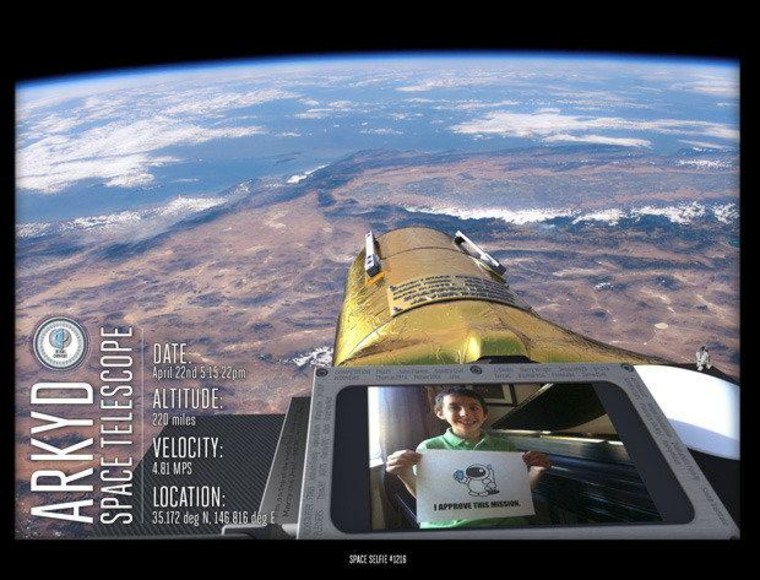The Planetary Resources asteroid-mining venture raised more than $300,000 on the first day of a million-dollar crowdfunding campaign that would let supporters use the company's space telescope to make astronomical discoveries — or just take "space selfies."
"If we're successful, we'll go off and create the material we need to do this public activity and make it happen," the venture's president and chief engineer, Chris Lewicki, told NBC News.
One of Planetary Resources' founders, Peter Diamandis, said the picture-taking plan was part of the company's goal to "democratize access to space."
The crowdfunding campaign was launched Wednesday at Seattle's Museum of Flight, not far from Planetary Resources' headquarters in suburban Bellevue.
Like other Kickstarter projects, this one offers a range of pledge levels, starting at $10 and going up to $10,000. For $25, you can have an image of your choosing displayed on a screen that's installed on Planetary Resources' Arkyd-100 telescope. A camera will capture an image of that image with Earth in the background — then send it back down to you. Lewicki said that's the first kind of picture he plans to take using the space telescope's imaging system.
"I want to see a selfie in space," he said during Wednesday's news conference.
For $99, you get the selfie, and you also get to sponsor five minutes of telescope time for students and scientists. For $150, you get to point the telescope yourself, for 30 minutes of exposure time. Higher pledge levels carry the promise of cooler goodies (Your video in space! A whole classroom's worth of telescope observations! Tours! Spacecraft models!).
The $10,000 level offers a school sponsorship, invites to the spacecraft's official unveiling and its launch, a chance to put your signature on the telescope, and the promise that your name will be proposed for one of the asteroids discovered by the telescope. (For the full range of pledge levels and premiums, check out Planetary Resources' Kickstarter page.)
The Arkyd-100's 8-inch (200mm) telescope would have an angular resolution of about 1 arcsecond, fine enough to make out an object the width of a dime from more than 2 miles (3.7 kilometers) away. Lewicki said it could detect objects as faint as 19th magnitude, which would theoretically let you track the distant dwarf planet Eris. You could focus the telescope on earthly objects, but it's much better-suited for astronomical observations.
Launch set for 2015
Lewicki said the online observation plan would be put into effect if the campaign reaches its $1 million goal by June 30. If not, Planetary Resources would still push ahead with its plan to launch the first Arkyd-100 in the latter half of 2015 — but it'd have to set aside the grand scheme for public engagement.
The Kickstarter idea emerged from months of discussions that followed Planetary Resources' unveiling more than a year ago. "We've been trying to figure out how to really best organize the energy that people have, and engage them and take them along for the ride," Lewicki said.
Eventually, the venture plans to use its space telescopes to hunt down near-Earth asteroids worth mining for precious metals, or for water that can be turned into fuel, air and other supplies for space travel. That could start happening around the end of this decade. In the meantime, Planetary Resources aims to generate revenue by selling its telescopes — or observation time on the telescopes. The company is also getting cash from technology development contracts with NASA and the U.S. military.
Each 24-pound (11-kilogram) telescope is expected to cost on the order of $10 million. That may sound like a lot when you compare it to a measly $1 million Kickstarter campaign, but Planetary Resources can rely on the backing of billionaire investors such as Google's Eric Schmidt and Larry Page. And the company says it expects asteroid mining to develop into an industry that generates trillions of dollars annually from space resources.
Telescopes for the masses
Space ventures ranging from Golden Spike to Liftport already have turned to online pledge drives for an extra kick. So is crowdfunding the wave of the future when it comes to the final frontier? "It's certainly something that is very new, and it has enabled a number of innovative ideas to come out and see the light of day that otherwise wouldn't," Lewicki said.
To get the word out about the campaign, Planetary Resources set up computer space at the museum for about 70 social-media evangelists, known as Vanguard members. David Ingram, a Seattle-based member of the International Dark-Sky Association, was sitting among the tweeters and the Facebookers — but he pointed out that there were other ways to bring telescopes to the people. Ingram cited the example of the New Hampshire Astronomical Society's Library Telescope Program, which makes 4.5-inch (115mm) telescopes available to library patrons for checkout.
"If we had 10,000 libraries with 25 telescopes each, think how that would revitalize public education," Ingram told NBC News. "But that's on the cheap and the down-low."
Which strategy do you prefer: the down-low, or the up-high? Or is there room for both? Feel free to weigh in with your comments below.
More about asteroids:
- Planetary Resources plans test launch in 2014
- Deep Space Industries joins asteroid marketplace
- Cosmic Log archive on asteroids
Alan Boyle is NBCNews.com's science editor. Connect with the Cosmic Log community by "liking" the NBC News Science Facebook page, following @b0yle on Twitter and adding the Cosmic Log page to your Google+ presence. To keep up with NBCNews.com's stories about science and space, sign up for the Tech & Science newsletter, delivered to your email in-box every weekday. You can also check out "The Case for Pluto," my book about the controversial dwarf planet and the search for new worlds.
